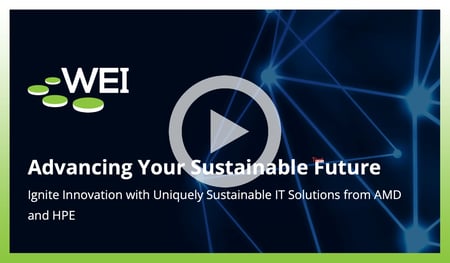 Today, many businesses are striving to be good corporate citizens to help ensure a sustainable world for future generations. Adopting environmentally and socially responsible practices, obtaining various sustainability certifications, and engaging in cause-related marketing are increasingly popular as they resonate with consumers who value sustainability.
Today, many businesses are striving to be good corporate citizens to help ensure a sustainable world for future generations. Adopting environmentally and socially responsible practices, obtaining various sustainability certifications, and engaging in cause-related marketing are increasingly popular as they resonate with consumers who value sustainability.
A critical area for sustainability efforts is reducing power consumption, particularly within an organization's IT estate. It has become common knowledge that data centers are notorious for high power usage. What may be lesser known is that the energy consumed is often inefficiently allocated. For example, a 2020 study revealed that over 65% of IT power consumption in data centers went to processing just 7% of the workload, underscoring the inefficiencies in older equipment.
This has led to the creation of new metrics such as Power Usage Effectiveness, (PUE) which calculates the ratio of total energy consumed by the data center to the energy used solely by the computers. For example, older data centers typically expended more energy on cooling than on computing power, but advancements in cooling technology have significantly lowered this energy requirement.
Watch this three-part theCUBE Executive Interview Series to learn how to make your enterprise more sustainable through innovative IT from AMD, HPE, and WEI.
 Sustainable IT Solutions On The Horizon
Sustainable IT Solutions On The Horizon
In the same way that household appliances are designed for better energy efficiency each year, modern servers and IT infrastructure are much more energy-efficient than their predecessors as improved application performance requires less servers. While the benefits of updating data center technology are clear, decisions on when to refresh equipment are often based on financial metrics such as total cost of ownership (TCO) and return on investment (ROI). However, these metrics do not always consider the full lifecycle impacts on performance, staffing, environmental effects, or the advantages of strategic lifecycle management.
Good intentions alone, without a strategic plan, remain mere intentions. Achieving sustainability goals necessitates careful planning and meticulous attention to detail. Here are four key benefits of optimizing technology refresh cycles.
1. Performance, power, and space benefits
Reducing the footprint of your data center has obvious benefits for your organization and the environment. While servers are an obvious target to capture power efficiency gains, they only serve as part of the equation. For instance, a typical storage environment can consume over 25% of the power consumed by a data center. Simple steps such as ensuring the transition from HDDs to SDDs can have a significant impact. In addition, RAID levels, compression, and deduplication technologies all have a direct impact on storage footprint and rack space capacity. Even the choice of your wireless technology can play a significant role as the recent Wi-Fi 6 standard addresses power management efficiency gains. Asset management must also pay attention to IoT devices as well.
2. Operational and cost efficiency benefits
A formal technology refresh cycle can produce significant operational and cost benefits. These benefits are not necessarily realized in a single task, but achieved through incremental performance improvements across your compute and storage systems. For instance, IDC research found that a three-year refresh cycle for servers cut staff management time and costs by 59%. Each refreshed server resulted in operational cost savings of $76,000 over three years when compared to running the older server. Another study showed suggested savings of $40K to $180K, per processor, in an Oracle environment with the potential for an almost $5M savings, per processor, for a business intelligence application.
Shorter lifecycles reduce the likelihood of equipment failure, minimize downtime, and decrease productivity losses. From a financial perspective, a regular investment in newer technology facilitates more predictable budgeting by distributing costs over time, avoiding the need for significant one-time expenditures on emergency upgrades or replacements. When you add up the benefits, careful attention to lifecycle management fosters a more efficient, secure, and financially manageable operational environment.

3. Residual Value Return
Even when servers are deemed insufficient for business needs due to technological advancements, higher power consumption, or compatibility issues with new software, they still retain a residual value. A key advantage of regular refresh cycles is resale value optimization. New servers also bring enhanced efficiency, superior performance, and lower maintenance expenses, which can help mitigate the cost of new hardware acquisitions. Planning ahead for product refresh cycles allows organizations to strategically manage their IT assets and ensure that they are always running on hardware that meets their performance and efficiency needs. In the meantime, optimizing the timing of asset disposition to maximize residual value is also taking place. Properly operationalizing this strategy requires careful coordination between IT, finance, facilities management, and procurement departments within an organization.
4. Technology Risk Mitigation
Technology advancements can evolve quickly, which means any technology solution carries an inherent risk of becoming obsolete sooner than expected. Regular refresh cycles ensure that an organization's IT infrastructure can support new software and technologies, mitigating the risk of obsolescence. Keeping your technology current can be crucial for maintaining a competitive advantage or at worst, keep up and not get left behind. It isn’t just technology obsolescence that is at risk, however. New hardware introduces advanced security features designed to guard against threat actors who exploit vulnerabilities in older systems. Legacy equipment can not only hinder the achievement of business objectives but also increase the risk of disruptive and expensive cyberattacks.
IT Partnerships With IT Sustainability In Mind
When IT assets are more efficient, they perform more computations or store
more data per unit of energy consumed, which leads to lower overall energy usage. This not only diminishes the demand for electricity, which is often generated from fossil fuels, but also reduces the heat generated by
these systems, further decreasing cooling requirements.
Companies must turn to equipment vendors that prioritize efficiency in their products. One example is the HP enterprise-focused company, HPE. A longtime WEI partner, HPE’s GreenLake Central platform provides a holistic view of infrastructure efficiency to enable easier management across a hybrid cloud environment.
To enhance energy efficiency, companies should implement energy management systems such as HPE’s OneView for real-time power monitoring and management to ensure that energy is used most effectively. These solutions help optimize equipment utilization, power consumption and thermal output. Emphasis should also be placed on regularly maintaining cooling systems, power supplies, and hardware to maintain optimal performance. Adopting modular data center designs can minimize energy waste associated with underutilized equipment, while the emergence of micro data centers is contributing to further advancements in this area.
Conclusion
The benefits of embracing regular product lifecycles are manifold, encompassing enhanced operational efficiency, improved security, and greater financial predictability. By staying ahead of technological obsolescence and leveraging the latest advancements, organizations can ensure continuous performance improvement and reduced risk of downtime. Ultimately, shorter product lifecycles represent a strategic investment in the future, positioning businesses to thrive in a rapidly evolving technological landscape.
Contact the WEI team to identify opportunities where IT sustainability can improve the efficiency of your enterprise. In the meantime, you can read our free tech brief, Harnessing Green IT 5 IT Sustainability Strategies For Efficiency In The Enterprise.











